
The ornament called the short appoggiatura has a long history. Throughout the 18th century it was notated simply as a small note of small value (e.g. an eighth or sixteenth note) close to, or slurred, to a normal note (the main note or principal note). It became common to add a diagonal slash or stroke through its stem circa 1830 (before 1800 in France). This was not intended to change its performance, but rather to more clearly distinguish it from the long appoggiatura.

The small-note-with-a-slash notation was not common earlier. For example, my understanding is that Mozart and Beethoven never used it. Appearances of this slashed note in their music (including in the Grove's article available below) are not original; the slashes have arbitrarily been added by copyists or editors.
The short appoggiatura is usually performed in modern music as a very short note inserted before the time of the main note. However, it was expected to be played in the time of the main note (on-beat) throughout the 19th century and into the 20th. It is often heard misinterpreted by performers of 19th century music.
Every rule in music has exceptions, but there is no question that on-beat performance of the small-note-with-a-slash was taught as the rule. It is stated over and over again in 19th century sources. Sometimes the language is not perfectly clear. A writer may say that the short appoggiatura takes "negligible time" or that is so quick that it seems to take no time from the principal note. Often (but not always) the short appoggiatura is said to be unaccented—the stress is to be on the main note—and this makes some (erroneously) believe that pre-beat performance is expected. Below are a few 19th century sources where the instructions for performance of the short appoggiatura are not ambiguous, because the directions are accompanied by illustrations!
Sometimes it may not be clear to a listener whether a short appoggiatura is pre-beat or on-beat, and the ambiguity may be OK. But I suggest that it is important to try to play it on-beat, and in that way one will come closer to the sound a late 18th or 19th century composer had in mind. Though it may be easier to play, a conspicuous anticipation of the beat can, in a good number of cases, sound lethargic and change the mood of what was intended to be lively.
(The short appoggiatura was called, inaccurately, an acciaccatura by a number of 19th century authors. The true acciaccatura is a keyboard ornament only, intended to strongly accent a note. Here is the article on the acciaccatura from the 1880 Grove's Dictionary.)
There were exceptions to the on-beat rule (e.g. Schumann sometimes put the appoggiatura symbol before a bar line and the main note after). To be fair to a minority opinion, one illustration of pre-beat short appoggiaturas will be included at the end of this page.


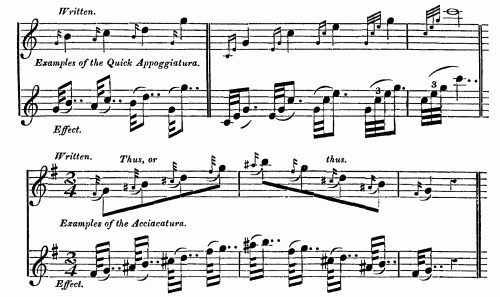
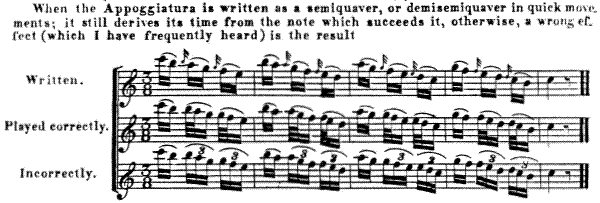
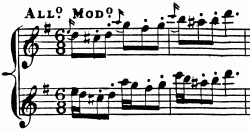
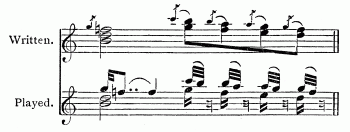
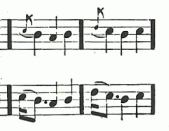


Part I of Rudolf Tillmetz's Melodic Etudes, Op.47, for two flutes is available in PDF format here (5 MB). Tillmetz indicates how all ornaments indicated by symbols or small notes are to be performed at the end of each etude.
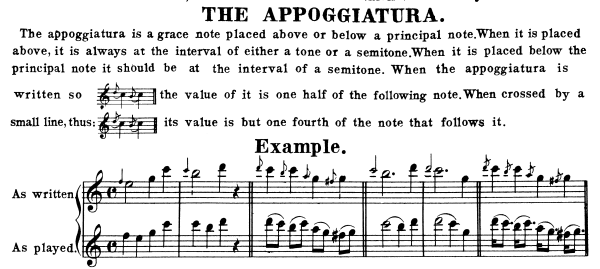

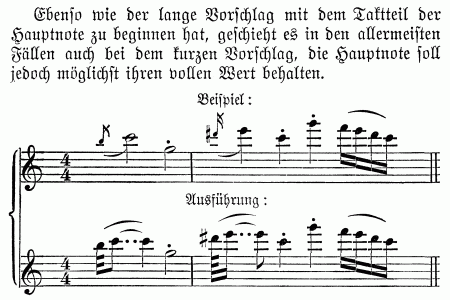
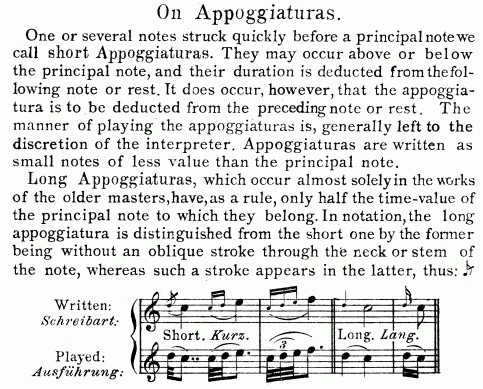
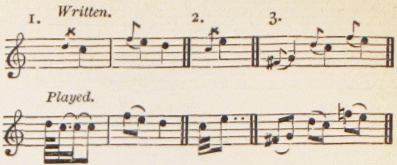
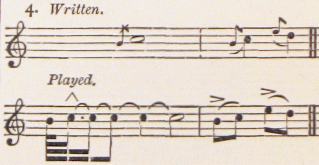
The complete article on the appoggiatura from the 1880 Grove's Dictionary is available in PDF format here (1.3 MB).
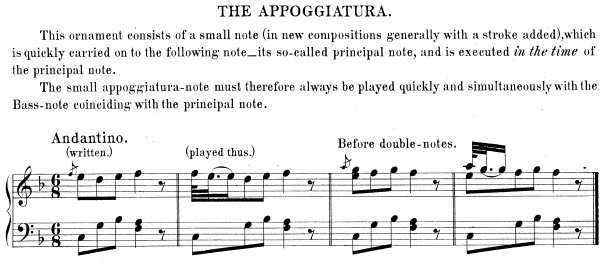
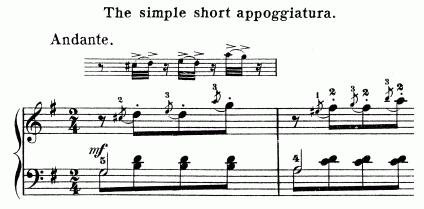
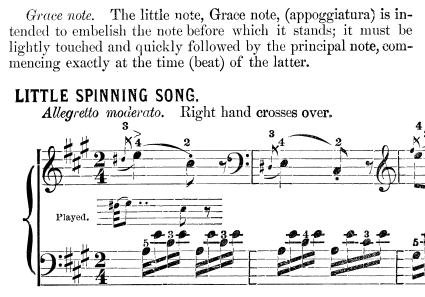
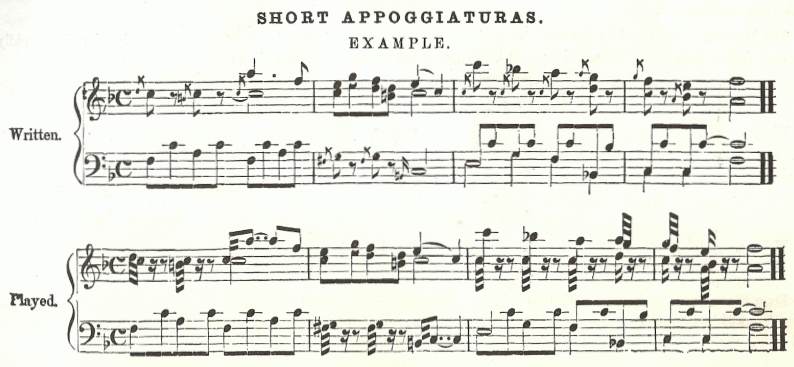
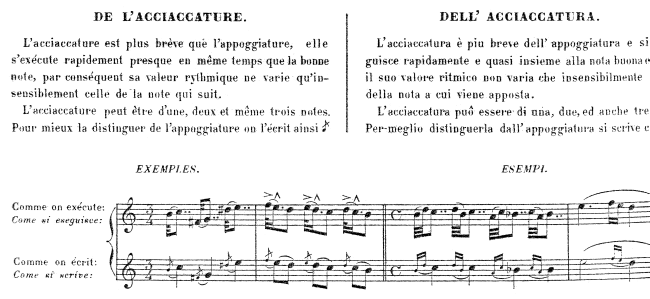
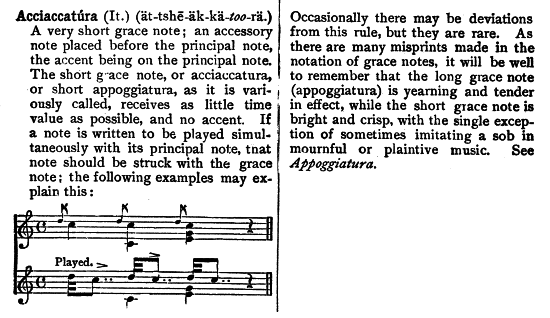
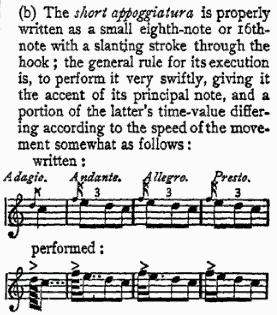
In 1912, the eminent musicologist Hugo Riemann gave the following remarks, in an article How to Execute Mordents, Trills and Appoggiaturas.
"In order to understand the intention of the composer, three things respecting the short appoggiaturas must be kept in mind, namely:
| 1. That a short appoggiatura has but the briefest time value. |
| 2. That it must be played directly at the beginning of the beat of the principal note, and |
| 3. That it must he played with a force equal to that of the principal note." |
Riemann avoids the ambiguous word "unaccented" and cautions that short appoggiaturas "must not he played too light, nor too weak" and "... false methods of execution are very prevalent [so that] much of the rhythmic value is lost ...". Among other examples, he suggests the execution on the right below for the example (on the left) from the second movement of Beethoven's Sonata Op. 31/1. (I have changed the first note on the right from a sixteenth-note to an eight-note.)
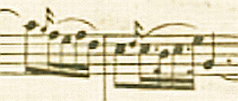
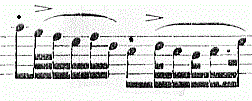

There were other dissenters. For example, in his Allgemeine Musiklehre für Lehrende und Lernende of 1883, Louis Köhler argues that the pre-beat short appoggiatura is intended by "new composers of importance" (without mentioning any of them by name).
